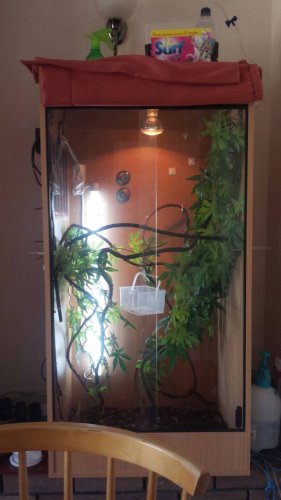cshawncarr
New Member
Wanted to get an opinion on substrate. I have a 6 month old male Yemen who is in a wooden viv with vented sides. Picture attached.
With my first chameleon I had no substrate which was easy to spot clean but did not look very good. The place I got my cham used very large Bark chips and suggested I also use them.
I decided to set up with the large chips and I love how natural the set up looks and it makes the Viv easier to clean each week (aside from spot cleans).
The one thing I have always struggled with has been water however. The bark chips thankfully don't soak up water but when I replace the substrate but the floor is constantly wet from the dripper. The viv is treated and water tight, but does not have any option for drainage.I was thinking of laying a 2inch layer of desert sand and then layer a couple of inches of bark on top. Would that help soak up excess water from the dripper? I'm not to worried about impaction as I have a cricket feed bin i move around the viv. so the cham is not feeding off of the floor. Ideally i don't want to set up a water collection tray but that would be the back up option. I jus just thought the sand underneath might do a better job of absorbing water. Thoughts?

With my first chameleon I had no substrate which was easy to spot clean but did not look very good. The place I got my cham used very large Bark chips and suggested I also use them.
I decided to set up with the large chips and I love how natural the set up looks and it makes the Viv easier to clean each week (aside from spot cleans).
The one thing I have always struggled with has been water however. The bark chips thankfully don't soak up water but when I replace the substrate but the floor is constantly wet from the dripper. The viv is treated and water tight, but does not have any option for drainage.I was thinking of laying a 2inch layer of desert sand and then layer a couple of inches of bark on top. Would that help soak up excess water from the dripper? I'm not to worried about impaction as I have a cricket feed bin i move around the viv. so the cham is not feeding off of the floor. Ideally i don't want to set up a water collection tray but that would be the back up option. I jus just thought the sand underneath might do a better job of absorbing water. Thoughts?



